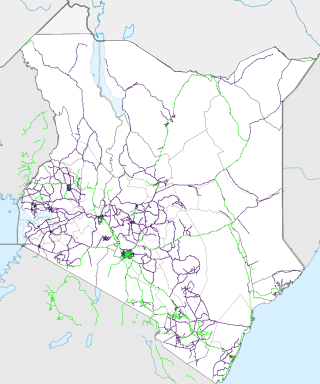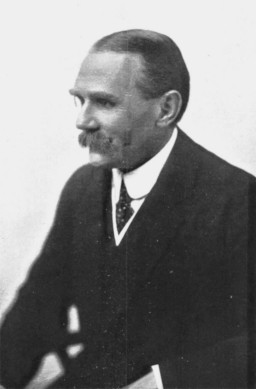
Transport in Kenya refers to the transportation structure in Kenya. The country has an extensive network of paved and unpaved roads.

Frederick John Dealtry Lugard, 1st Baron Lugard, known as Sir Frederick Lugard between 1901 and 1928, was a British soldier, mercenary, explorer of Africa and a colonial administrator. He was Governor of Hong Kong (1907–1912), the last Governor of Southern Nigeria Protectorate (1912–1914), the first High Commissioner (1900–1906) and last Governor (1912–1914) of Northern Nigeria Protectorate and the first Governor-General of Nigeria (1914–1919).

The Protectorate of Uganda was a protectorate of the British Empire from 1894 to 1962. In 1893 the Imperial British East Africa Company transferred its administration rights of territory consisting mainly of the Kingdom of Buganda to the British government.

The Uganda Railway was a metre-gauge railway system and former British state-owned railway company. The line linked the interiors of Uganda and Kenya with the Indian Ocean port of Mombasa in Kenya. After a series of mergers and splits, the line is now in the hands of the Kenya Railways Corporation and the Uganda Railways Corporation.

Kisumu is the third-largest city in Kenya after the capital, Nairobi, and Mombasa. It is the second-largest city after Kampala in the Lake Victoria Basin. The city has a population of slightly over 600,000. The metro region, including Maseno and Ahero, has a population of 1,155,574 people according to the 2019 Kenya Population and Housing Census which was conducted by the Kenya National Bureau of Statistics.
This is a survey of the postage stamps and postal history of British East Africa.

Lake Victoria ferries are motor ships for ferry services carrying freight and/or vehicles and/or passengers between Uganda, Tanzania, and Kenya on Lake Victoria.

Sir Frederick John Jackson, was an English administrator, explorer and ornithologist.

East Africa Protectorate was a British protectorate in the African Great Lakes, occupying roughly the same area as present-day Kenya, from the Indian Ocean inland to the border with Uganda in the west. Controlled by the United Kingdom in the late 19th century, it grew out of British commercial interests in the area in the 1880s and remained a protectorate until 1920 when it became the Colony of Kenya, save for an independent 16-kilometre-wide (10 mi) coastal strip that became the Kenya Protectorate.

Sir William Mackinnon, 1st Baronet, was a Scottish ship-owner and businessman who built up substantial commercial interests in India and East Africa. He established the British-India Steam Navigation Company and the Imperial British East Africa Company.
Charles William Hobley, CMG — known as C. W. Hobley — was a pioneering British Colonial administrator in Kenya. He served the Colonial Service in Kenya from 1894 until his retirement in 1921 and published a number of monographs on a variety of subjects.

The Sultanate of Zanzibar, also known as the Zanzibar Sultanate, was an East African Muslim state controlled by the Sultan of Zanzibar, in place between 1856 and 1964. The Sultanate's territories varied over time, and after a period of decline, the state had sovereignty over only the Zanzibar Archipelago and a 16-kilometre-wide (10 mi) strip along the Kenyan coast, with the interior of Kenya constituting the British Kenya Colony and the coastal strip administered as a de facto part of that colony.
Dagoretti is an area in the western part of Nairobi, the capital of Kenya. It straddles the Nairobi and Kiambu County boundary with the Dagoretti Road Reserve marking the psychological border point heading Northerly and North-Easterly. Administratively it is one of eight divisions of Nairobi. The Dagoretti division is divided into six Locations. The former electoral Dagoretti Constituency had the same boundaries as the now defunct Dagoretti division.
The Mackinnon-Sclater road was a 970 km (600 mi) ox cart track from Mombasa to Busia in Kenya started in 1890 by the British East Africa Company (IBEAC). It superseded earlier caravan routes used by slave traders and explorers of the interior.
SS William Mackinnon was a steamboat on Lake Victoria in East Africa. She was named after Sir William Mackinnon, founder of the Imperial British East Africa Company (IBEAC).
SS Sybil was a cargo and passenger Lake Victoria ferry in East Africa.
PS Lugard II was a British passenger ferry in Uganda. She was a side wheel paddle steamer with a shallow draught in order to operate on the Victoria Nile and Albert Nile. She was named after Frederick Lugard, 1st Baron Lugard, who late in the previous century had explored Uganda, secured much of it for the British Empire and served as its Military Administrator 1890–92.
Kenya and Uganda Railways and Harbours (KURH) ran harbours, railways and lake and river ferries in Kenya Colony and the Uganda Protectorate from 26. February 1926 until 1. May 1948. It included the Uganda Railway, which it extended from Nakuru to Kampala in 1931. In the same year it built a branch line to Mount Kenya.

SS Kavirondo was a steam tug on Lake Victoria in East Africa. She was named after a local Lake Victoria region and was one of many compact Lake Victoria steamships operated by the Uganda Railway.

George Wilson CB also known as bwana tayari - "Mr. Ready", amongst natives in East Africa, was a general African staff employee of the Imperial British East African company (1890–1891). He served as Chief Lieutenant to then-Captain Sir Frederick D. Lugard from 1889 to 1890, and was second in command during Lugard's caravan expedition to Uganda on 6 August 1890. The Europeans were Fenwick De Winton, William Grant, and Archibald Brown. Wilson joined the Uganda Service/government in 1894 and his first order of business was establishing a 'native baraza' or council that was structured as a native administration, with himself as the chief administrative officer who presided over all matters involving the government in conjunction with the Kabaka and later on he was in civil charge of the Protectorate during the outbreak of the Sudanese mutiny. He was appointed first class transport officer then the 1st class assistant of the Uganda protectorate on 30 August 1894. Was the sub-commissioner of the Buganda Kingdom in 1895. Also Was Her Britannic Majesty's acting commissioner and the commander in chief of the Uganda Protectorate and the consul-general. Was awarded the C.B. on 2 January 1899. He was the first ever Chief collector for the Bunyoro district. He was tasked with drawing up the 1901 Ankole agreement and presenting it to the Ankole chiefs and the Ankole people before it was signed in August of that year with the blessing of Ankole, the colonial administration and the UK government in Whitehall with Wilson as the protectorate's Chief negotiator and representative. Mr. Wilson was then the deputy commissioner of the Uganda Protectorate at Entebbe, government house and deputy governor of the protectorate. He was H.M. – His Majesty's commander in chief and acting commissioner of the Uganda protectorate (1904–1906) and. Was a fellow at the Royal Society of Arts and a silver medal recipient since 28 June 1907.














